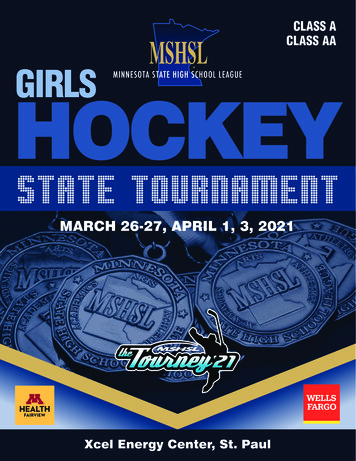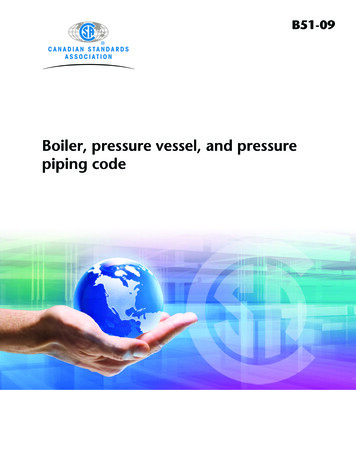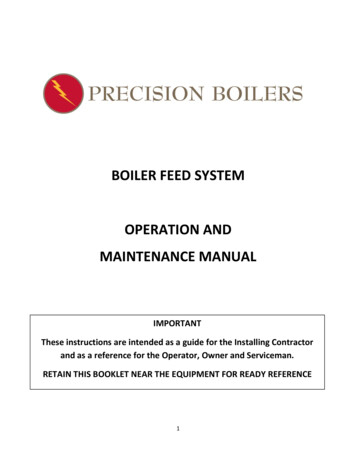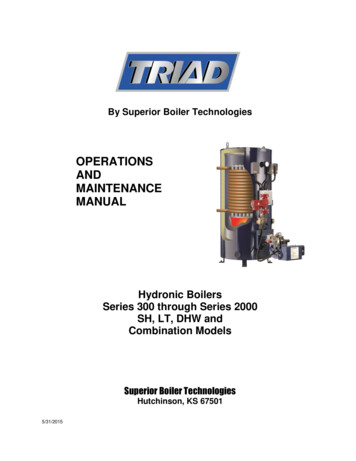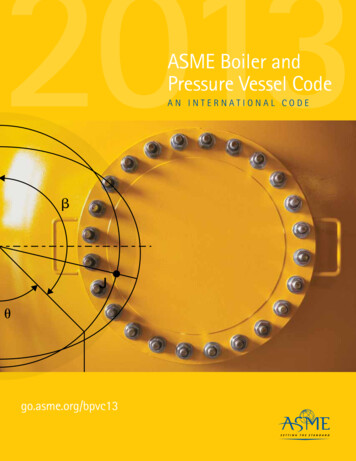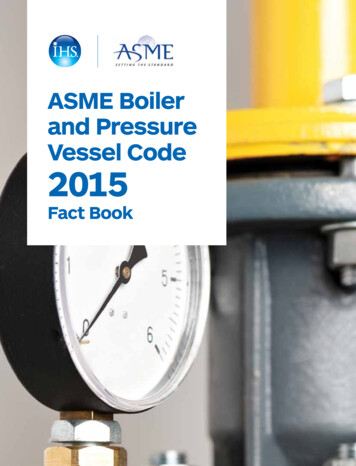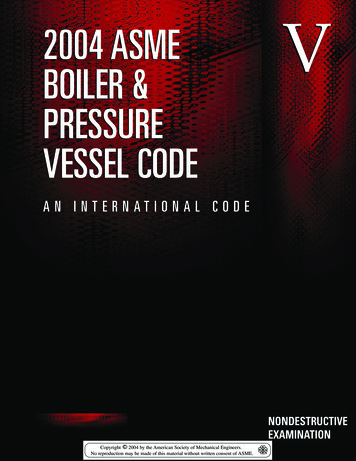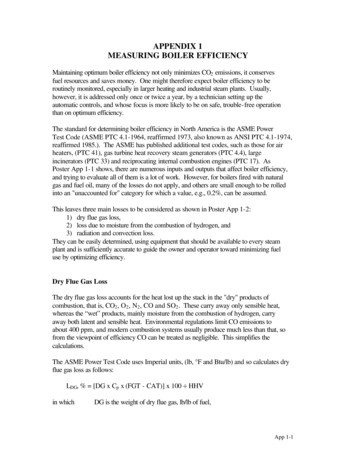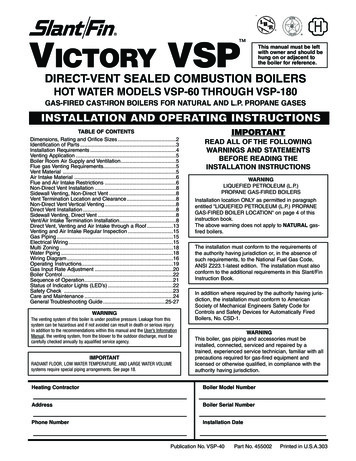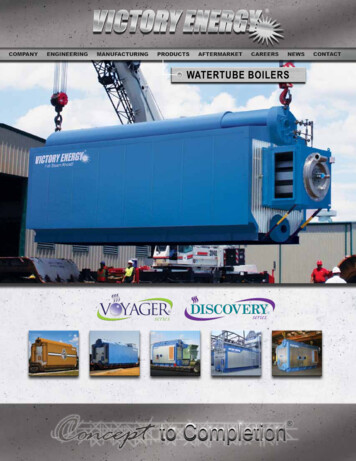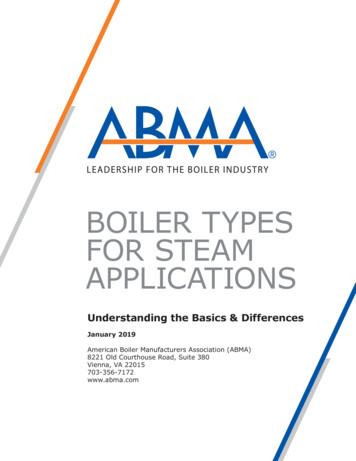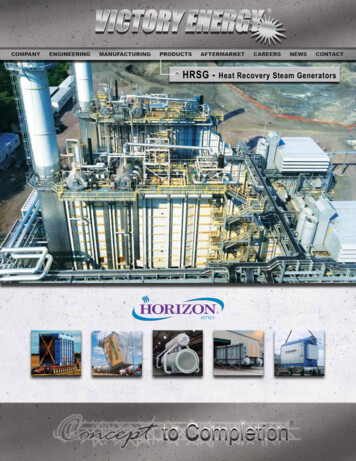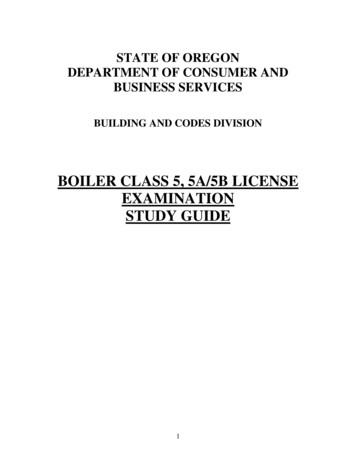
Transcription
STATE OF OREGONDEPARTMENT OF CONSUMER ANDBUSINESS SERVICESBUILDING AND CODES DIVISIONBOILER CLASS 5, 5A/5B LICENSEEXAMINATIONSTUDY GUIDE1
General Information for all LicenseesThe following study guide is to be used to assist you in preparing for the questions on the Stateof Oregon Boiler Licensing Exams. This is not an extensive listing of knowledge expected froma “Qualified Certified Person.” Where there are general discussions of ASME, NBIC, and NFPACode requirements or of Oregon Administrative Rules or statutes, the study guide is notcontrolling: the applicable code, rule or statute is the final authority.The exam questions are randomly selected from a set of over 400 questions that coveradministrative rules, ASME, NBIC and NFPA Codes, materials, math, drawing, repairs, physicalscience, safety, trade knowledge and welding for Class 4 and Class 5 candidates. The examquestions are based upon the knowledge and experience that is expected of candidates for theClass certification being attempted.The rules for licensing of persons installing, altering or repairing boilers or pressure vessels arelisted in ORS 480.630 through ORS 480.645. Requirements for each “Qualified CertifiedPerson” who can be licensed to install, alter or repair boilers, pressure vessels and pressurepiping in the State of Oregon are listed in OAR 918-225-0691. These consist of Class 2, Class 3,Class 4, Class 5, Class 5-A and Class 5-B. The Class 1 Trainee/Helper and Class 6 Welder arenot required to take and pass the Oregon Boiler License Exam to be certified. The exam coversthe Oregon Revised Statutes and the Oregon Administrative Rules for boilers and pressurevessels but this study guide does not cover those administrative rules. These administrative rulesmay be printed off the web site for review and are available on line s/boiler.html Boiler Statutes: Oregon Revised Statutes (ORS) 480.510 to 480.670Boiler Administrative Rules: Oregon Administrative Rules(OAR)918-225-0220 through 918-225-0800The 2015 Oregon Boiler and Pressure Vessel Specialty Code containing the minimum safetystandards for boilers, pressure vessels, pressure piping, nuclear components, parts, items, andrepair and alteration procedures follow:(1) ORS 480.510 to 480.670 and OAR chapter 918, division 225;(2) The Boiler and Pressure Vessel Code of The American Society of Mechanical Engineers(ASME), 2013 Edition as published, including Section I; Section II, Parts A, B,C and D; SectionIV; Section V; Section VIII, Division 1, 2 and 3; Section IX; and Section X.(3) The 2012 Edition of the ANSI/ASME B31.1 Power Piping Code.(4) The 2012 Edition of the ANSI/ASME B31.3 Process Piping Code.(5) The 2013 Edition of the ANSI/ASME B31.5 Refrigeration Piping Code.(6)The 2011 Edition of the ANSI/ASME B31.9 Building Service Piping Code.2
(7) The 2013 Edition of the National Board Inspection Code (NBIC) ANSI/NB 23;(8) The 2011 Edition of NFPA 85, Boiler and Combustion Systems Hazards Code; and(9) The 2012 Edition of ASME CSD-1, Controls and Safety Devices for Automatically FiredBoilers.The ASME Codes listed above are “codes of construction” and list the allowable design,materials, construction and installation of Code items. The NBIC lists the installationrequirements and the permissible repairs to Code items.This study guide will summarize sections of the above codes and discuss trade practices to assistin passing the Boiler license exam. For a more complete understanding of the above Codes, referto the individual Code sections.Class 5Class 5 Pressure Piping Mechanic. A person holding this license may fabricate, install, alter andrepair pressure piping; install boilers and pressure vessels by attachment of piping connections;and install, assemble and repair cast iron sectional boilers. Applicants shall:1. Have a minimum of 2,000 hours of experience performing pipe-welding or brazing onB31 pressure piping and 2,000 hours of experience performing work on pressure piping.Experience must be verified as established in OAR division 30; and2. Pass an examination testing the applicant's knowledge of:A. American Society of Mechanical Engineers Boiler and Pressure Vessel Code,Sections I, II, IV, V, VI, VII, VIII, IX, CSD-1 and B 31 Pressure Piping;B. Structural and mechanical blueprints with the ability to interpret specifications;C. Pressure piping systems and controls;D. Boiler and Pressure Vessel Laws, ORS 480.510 to 480.665 and OAR chapter 918,division 225; andE. Welding, brazing, chemical bonding procedures, heat treatment, metallurgy andother procedures applicable to pressure piping systems.Class 5-AClass 5-A Process Piping Mechanic License. A person holding this license may fabricate, install,alter or repair B31.3 process piping. Applicants shall:3
1. Have a minimum of 2,000 hours of experience performing pipe-welding or brazing onB31.3 process piping and 2,000 hours of experience performing work on pressure piping.Experience must be verified as established in OAR division 30; and2. Pass an examination testing the applicant's knowledge of:A. American Society of Mechanical Engineers Boiler and Pressure Vessel Code,Section B31.3;B. Structural and mechanical blueprints with the ability to interpret specifications;C. Pressure piping controls;D. Boiler and Pressure Vessel Laws, ORS 480.510 to 480.665 and OAR chapter 918,division 225; andE. Welding, brazing, chemical bonding procedures, heat treatment, metallurgy andother procedures applicable to pressure piping systems.ASME B31.3 Category “M” piping is designated as lethal service piping. Category “M” piping isdesignated by the system owner and must be inspected by a Certified Process Piping Inspectorthat is employed by the piping system’s owner.All piping systems should be designed with consideration of vibration, thermal and seismicloadings.Class 5-BClass 5-B Refrigeration Piping Mechanic License. A person holding this license may fabricate,install, alter or repair B31.5 refrigeration piping. Applicants shall:1. Have a minimum of 2,000 hours of experience performing pipe-welding or brazingon B31.5 refrigeration piping and 2,000 hours of experience performing work onpressure piping. Experience must be verified as established in OAR division 30; and2. Pass an examination testing the applicant's knowledge of:A. American Society of Mechanical Engineers Boiler and Pressure Vessel Code,Section B31.5;B. Structural and mechanical blueprints with the ability to interpret specifications;C. Pressure piping controls;4
D. Boiler and Pressure Vessel Laws, ORS 480.510 to 480.665 and OAR chapter 918,division 225; andE. Welding, brazing, heat treatment, metallurgy and other procedures applicable topressure piping systems.Piping systems for refrigeration piping may utilize materials that meet the ASME B31.5 Code.These materials may be reclaimed provided the piping is properly identified. Bending and coldspringing to align pipe is allowed providing the finished piping surface is free of cracks andbuckles. Bell and Spigot type fittings may not be used. Toxic service fluids cannot use cast ormalleable iron fittings. Piping designs for exposed piping systems must include the effects ofwind loading. All pressure piping systems shall be designed for seismic loadings.ASME Section IX covers brazing requirements.A3 and B3 refrigerant piping butt and miter groove welds require both visual and 5%radiographic inspection.Pressure testing of refrigeration piping systems shall be at least 110% but not more than 130% ofthe system design pressure.Pressure Vessel InstallationsPiping AttachmentsFlanged Attachments- The bolts in a flanged connection must exhibit full threadengagement. This means that bolts shall engage so that the threading goes completely throughthe nut. Follow manufacturers’ recommendations when tightening flange bolts.Threaded fittings- Completed thread fittings must leave at least two threads exposed. Inaddition, different sized fittings have a minimum number of threads that must be engaged in thefitting. Minimum thread engagement in threaded fittings are as follows: Under 1-1/2” NPS4 threads 1-1/2” & 2” NPS5 threads 2-1/2” to 4” NPS7 threads 5” & 6” NPS8 threads 8” NPS10 threads 10” NPS12 threads 12” NPS13 threadsEXAMPLE: A 2” NPS fitting must have at least 5 threads engaged and must leave at least 2threads exposed.Piping Materials Piping materials for ASME applications must be listed in ASME Section II. ASME-listed piping materials must have identifying marks recording the piping type,manufacturer and heat numbers of the batch for traceability.5
When ASME piping materials are cut, the identifying numbers must be transferred to thecut pieces. Since coatings would make the identifying markers unreadable, painting priorto installation or galvanizing is not allowed.Some non-metallic piping, including plastic piping, is listed in ASME Section II and isallowed in ASME B31.9, Building Service Piping, but the use of PVC plastic pipe is notallowed.PVC piping may not be used because it may fracture under pressure and will becomebrittle when cold. In air compressors, PVC could be affected by compressor oils in theair stream.ASME B31.9, Building Service Piping covers piping systems operated at pressures up to150 psi.Used pipingUsed piping and piping fittings may only be used after thorough cleaning and inspection by anauthorized inspector. If identifying marks are not clearly visible, the inspector may requiremechanical and/or chemical testing to verify the composition of the material.Pressure testing of vessels and piping systemsLeak testing of pressure vessels and piping systems may be required by an inspector. The Tosafely pressurize a system for a leak test: the system’s pressure must be gradually increased to a required test pressure (provided bythe inspector) the test pressure must be maintained for a designated period of time, generally between10 to 20 minutes. If water is used to perform the leak test, the metal temperature must be at least 60oF toassure the vessel is not thermally stressed. For personnel safety, the temperature shouldnot exceed 120oF. If air or nitrogen is used to perform the leak test, the test will be performed at lowerpressures and must first be approved by an inspector. Air and nitrogen under pressurehave high kinetic energy and could create an explosion if there is a rupture.Piping weight and hydrotestsWhen installing piping, the additional weight that will be applied during a hydrotest must betaken into consideration. Even air piping must be installed so that it can bear the weight that willbe applied during a hydrotest. Thus, an installer must know the weight of the entire pipingsystem in order to properly design and select pipe supports and hangers.To know the weight of a section of pipe that is filled with water, you must know: The weight of the pipe per foot of run The volume inside the pipe The weight of the water required to fill that volumeFiguring out this information sometimes requires the use of basic math and the memorization ofsome basic facts about the weight of water and the volume of water within an area.6
Mathematical terms related to circles: CircumferenceDiameter RadiusFor the purposes of using math in the field, (pi) is rounded off to be 3.14You should also know how to convert fractions into decimals:To convert ¾ into a decimal, divide 3 by 4, which would give you .75You can use a calculator to do this, or you could do it long hand by adding a decimal point andzero to the top half of the fraction (dividing 3.0 by 4) and putting your answer to the right of thedecimal point your answer.½ .50 [1.0 2 .50]1/3 .333 [1.0 3 .333]4/5 .80 [4.0 5 .80]7/8 .875 [7.0 8 .875]Area of a circleThe formula for calculating the area of a circle is:Radius x Radius x 3.14 Area( r2 Area)Example- For a 6 inch diameter pipe, the radius equals one half of the diameter, 3 inches3 inches x 3 inches x 3.14 28.3 square inchesCircumference of a circleThe formula for calculating the circumference of a circle is:Diameter x 3.14 Circumference27
( d Circumference)Example- For a 6 inch diameter pipe,6 inches x 3.14 18.84 inches in circumferenceAlso, with pipes there are two circumferences: the inner circumference (the circle that is on the inside of the pipe) the outer circumference (the circle that is on the outside of the pipe)As pipes get larger there can be a substantial difference between the inner circumference and theouter circumference.To calculate the inner circumference you would use the diameter of the inside of the pipe.To calculate the outer circumference, your diameter would be the diameter from the insideof the pipe plus the thickness of the pipe.Example- The outer circumference of a ½” thick pipe with a 6 inch inner diameter would be:7 inches (6” inner diameter plus ½” thickness on both sides) x 3.14 21.98 inchesVolume of a cylinder (or pipe)The formula for calculating the volume of a cylinder is:Area x Length VolumeExample- For a 6 inch pipe with a 24 inch run (length):28.3 inches x 24 inches 679.2 cubic inches of volumeCalculating gallons of water per cubic inchThe formula for knowing how much water is in a volume of pipe is:One gallon of water 231 cubic inches of pipingWe know from the previous calculations that a 6 inch pipe that runs 24 inches pipe holds 679.2cubic inches of water volume.679.2 (volume in cubic inches) 231 (# of cubic inches in a gallon) 2.94 gallonsWeight of waterThe formula for the weight per gallon of water is:One gallon of water weighs 8.34 poundsSince our 6 inch pipe that runs 24 inches holds 2.94 gallons of water we can determine theweight of the water as follows:2.94 gallons x 8.34 pounds 24.5 pounds of waterPressure of water8
The formula to determine the pressure of water at the bottom of a column of water (for example,the bottom of a pipe or tank) is:Height of the column in feet
5 D. Boiler and Pressure Vessel Laws, ORS 480.510 to 480.665 and OAR chapter 918, division 225; and E. Welding, brazing, heat treatment, metallurgy and other procedures applicable to pressure piping systems. Piping systems for refrigeration piping may utilize materials that meet the ASME B31.5 Code.
